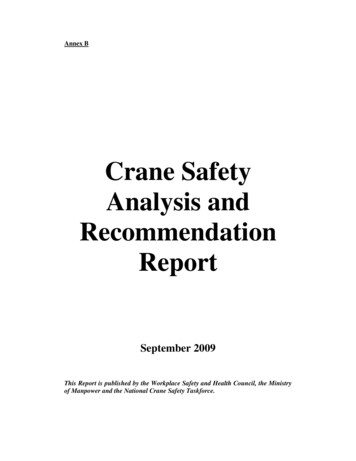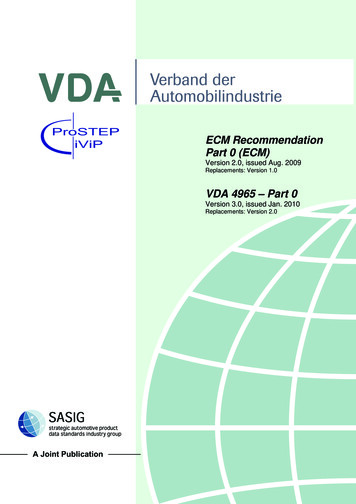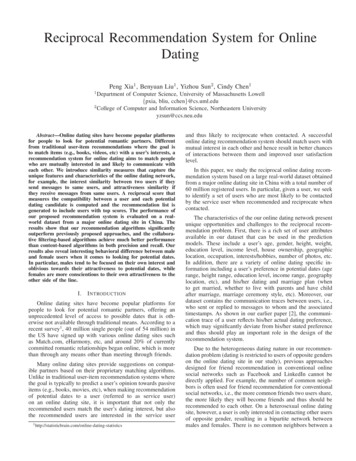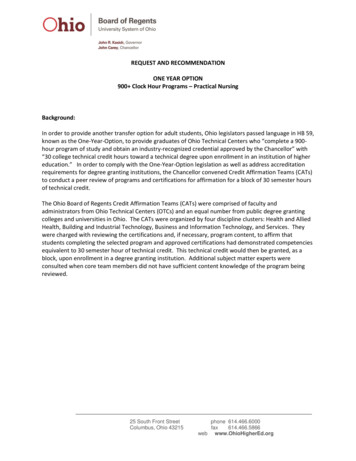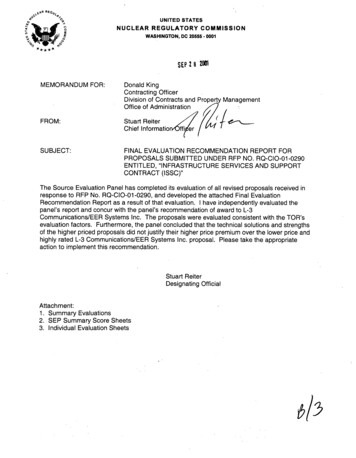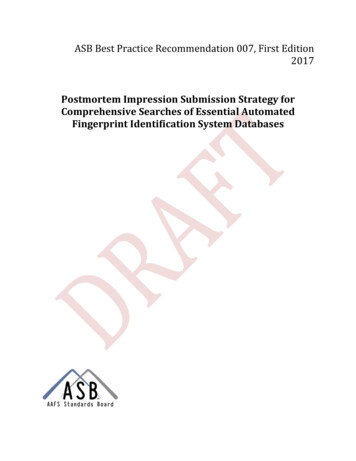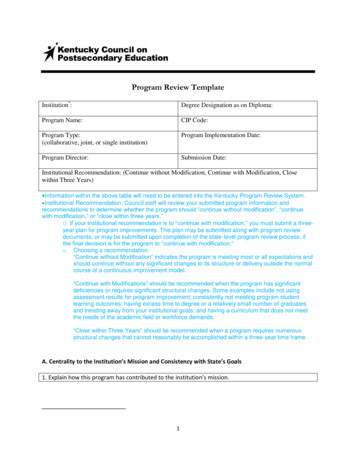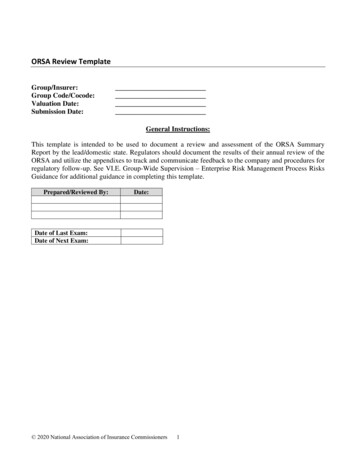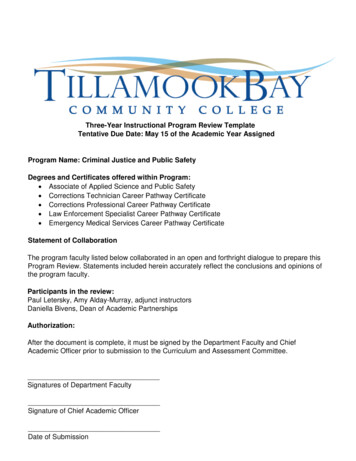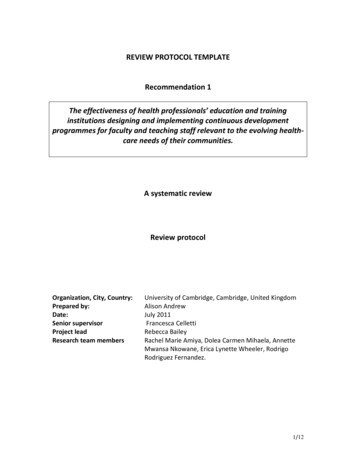
Transcription
REVIEW PROTOCOL TEMPLATERecommendation 1The effectiveness of health professionals’ education and traininginstitutions designing and implementing continuous developmentprogrammes for faculty and teaching staff relevant to the evolving healthcare needs of their communities.A systematic reviewReview protocolOrganization, City, Country:Prepared by:Date:Senior supervisorProject leadResearch team membersUniversity of Cambridge, Cambridge, United KingdomAlison AndrewJuly 2011Francesca CellettiRebecca BaileyRachel Marie Amiya, Dolea Carmen Mihaela, AnnetteMwansa Nkowane, Erica Lynette Wheeler, RodrigoRodriguez Fernandez.1/12
Table of Contents. 1TO INVESTIGATE THE EFFECTIVENESS OF CONTINUOUS DEVELOPMENT PROGRAMMES FOR FACULTYAND TEACHING STAFF, INCLUDING CURRENT HEALTH WORKERS, WHICH UPDATE AND DEVELOPTEACHING SKILLS (E.G. CURRICULUM DEVELOPMENT AND INSTRUCTIONAL DESIGN), IN BOTHUNDERGRADUATE AND POSTGRADUATE PROGRAMS, ON THE QUANTITY, QUALITY AND RELEVANCE OFHEALTH PROFESSIONALS. 1A SYSTEMATIC REVIEW . 11.0Background .42.0Objective .43.0Review Question .44.0Evidence gathering and study selection .55.0Assessment of risk of bias and data extraction .76.0Data synthesis .87.0Dissemination .88.0Resource implications .89.0References .8Appendix A: database search strategy .10Appendix B: data extraction forms (see attached excel workbook) .12Appendix C: Example of databases, websites and journals which could be searched .122/12
1.0 BackgroundInclude definitions, answers to background questions, description of the intervention and how it mightwork to help better understand the question.This question refers to the effectiveness of continuous development programmes forfaculty and teaching staff which are focused on which updating and developing teachingskills. Such interventions could be in the form of one off workshops, seminars or shortcourses or continuing programmes such as fellowship schemes; all aimed at improvingteaching ability. There have been systematic literature reviews that have analysed theeffectiveness of such interventions (most notably Steinert et al. 2006 reviewed theeffectiveness of such interventions in medical education) yet the primary issue lies in theoutcomes measured. Few studies have measured the effect of such programmes pastthe level of participants’ reaction to the programme. Studies that measured furtheroutcomes (learning in the form of a change in attitudes, knowledge or skills, a change inbehavior or results in the form of a change in the system/ organizational practice or achanges in learning or performance of health students) were those included in Steinert'ssystematic review. However, since the outcomes of interest in this systematic revieware the quantity, quality and relevance of health graduates and health practitioners theonly outcomes relevant to this literature review are those measured are changes in thequantity, quality and relevance of health graduates or professionals that can bespecifically attributed to such continuous development programmes for faculty andteaching staff. Other process outcomes will be recorded but are not relevant for thepurpose of evaluation of evidence.2.0 ObjectiveTo investigate the effectiveness of Continuous Development Programmes for faculty andteaching staff, including current health workers, which update and develop teachingskills (e.g. curriculum development and instructional design), in both undergraduate andpostgraduate programs, on the quantity, quality and relevance of health professionals.3.0 Review QuestionFor the purposes of this literature review, the population, intervention, comparatorsand outcomes (PICO) framework to inform the review objectives are presented ty andContinuousNo ContinuousQuantity, qualityteaching staffDevelopmentDevelopmentand relevance ofprogramsProgrammes forProgrammes forhealth professionalsfaculty and teaching faculty and teachingstaff which updatestaff which updateand developand developteaching skillsteaching skills3/12
4.0 Evidence gathering and study selectionSee Appendix C for examples of databases, websites and journals which may besearched.4.1 Evidence gatheringThe evidence gathering approach will have four components:4.1.1 Searching databasesThe databases in the table below will be searched with a pre-determined strategy asdetailed in Appendix A. In cases where the search results are small in number, searchterms will be reduced to maximize the search sensitivity.Topic/FieldEx: EducationHealthDatabaseEx: ERIC, Campbell, Education Research Complete PUBMED4.1.2 Hand searchingThe following journals and websites will be hand-searched for relevant articles:Resources that will be searched by hand Teaching and Teacher Education Academic Medicine Medical Teacher International Journal for Academic Development Biomed (http://www.biomedcentral.com/) WHO's Library Database (WHOLIS) Website of the Foundation of Advancement of International Medical Educationand Research (FAIMER) International Council of Nurses Council on Graduate Medical Education American Academy of Family Physicians American College of Physicians4/12
4.1.3 Expert network consultationsA network of health professional education experts will be consulted by email to identifyadditional grey literature or research that has not been found through the aboveprocesses. The following experts and networks will be contacted.Experts and networks will be contacted regarding additional articlesConsultation with relevant members of the Core Guidelines Development Group4.1.4 Reference searchesBibliographies of those papers that match the eligibility criteria below will be searchedby hand to identify any further, relevant references, which will be subject to the samescreening and selection process.4.2 Eligibility criteriaAfter gathering the evidence, the following eligibility criteria will be applied to theresults and all identified references screened independently by two reviewers (AaronStoertz and Francesca Celletti) using a three-stage approach to reviewing the title,abstract and full text.4.2.1 Types of studies:All types of evaluative study designs are eligible for inclusion, including grey literature.Studies will not be selected on methodological quality.4.2.2 Types of participants:This is a succinct description of the types of participants that you will include. For example, you mightcopy the health professionals definition here.The participants this literature review will include are faculty and teaching staffincluding current health workers and/or residents or interns who also teach studentsfrom any of the health professions listed below.To facilitate the development of the WHO guidelines for transforming and scaling-uphealth professional education and training, the literature review will include thefollowing lists of health professionals, as defined by the International StandardClassification of Occupations (ISCO) (WHO, 2010a; ILO, 2008):Core List Medical Doctors - both Generalist and Specialist Practitioners, including PublicHealth Doctors (ISCO-08 minor group 221)Nursing Professionals, including Public Health Nurses (ISCO-08 minor group 222, unit2221)5/12
Midwifery Professionals, including Public Health Midwives (ISCO-08 minor group222, unit 2222)Dentists (ISCO-08 minor group 226, unit 2261)Pharmacists (ISCO-08 minor group 226, unit 2262)4.2.3 Types of intervention:This is a succinct description of the types of intervention you will include.Continuous Development Programmes for faculty and teaching staff which update anddevelop teaching skills. There is a wide variety of programmes that qualify as such e.g.workshops, seminars, short courses, fellowship schemes.Articles that focus on programmes that develop and enhance teaching skills andeducational methods (including PBL) not programmes that develop teaching content.4.2.4 Types of outcome measures:The primary outcomes of interest are the quantity, quality and relevance of practicinghealth professionals. These are defined by a number of measurable outcomes found inthe Outcomes Framework document. Other important outcomes include values andpreferences, resource use/costs, benefits and harms, as well as all other unintendedeffects of the intervention. Studies that include other outcomes should not be excludedat this stage in the evidence retrieval. Other secondary outcomes can also be defined, as needed.4.3 Exclusion criteriaEditorials, newspaper articles and other forms of popular media will be excluded.Failure to meet any one of the above eligibility criteria (section 3.2) will result inexclusion from the review and any apparent discrepancies during the selection processwill be resolved by a third, independent reviewer. The number of excluded studies(including reasons for exclusion for those excluded following review of the full text) willbe recorded at each stage.5.0 Assessment of risk of bias and data extractionFollowing the initial selection of literature, the reviewers will consult with the WHOSecretariat regarding the process to be followed for summarizing the studies. Data willbe extracted from relevant papers using predefined evidence summary templatesattached in Appendix B. Data will be collected regarding the reasons for exclusion,6/12
characteristics of included studies, participants, interventions (including comparators)and outcomes. The final decision for inclusion or exclusion will be made by a teamconsisting of the WHO Secretariat, methodologist and researchers conducting thereview. Any potential disagreement will be recorded and resolved by further discussion.Risk of bias across studies will be assessed using the approach outlined by the Gradingof Recommendations Assessment Development and Evaluation (GRADE) working group.Any disagreements will be recorded and resolved by involvement of an additionalreviewer.6.0 Data synthesisThe availability of appropriate data and resources to conduct a meta-analysis will beconsidered, where feasible.7.0 DisseminationA final set of tables including a GRADE Evidence Table and Descriptive Evidence Tablewill be produced and submitted to the WHO Secretariat as stipulated in the Proceduresfor the Retrieval of Evidence and Summary of Evidence. In addition, a manuscript will beprepared for submission to a peer-reviewed journal (a more specific dissemination proposal cango here as well).8.0 Resource implicationsThe project lead will work closely with the WHO Secretariat to define the scope andmethods of the review and facilitate access to unpublished literature, supportingtranslation of foreign language literature where necessary. Proposed milestones andtimescales are outlined below:MILESTONESIdentification and retrieval of the evidenceConduct literature review, hand searching, and contacts with experts and networksSummarizing evidence in DescriptiveEvidence Tables (Table 1. Summary of systematic literature reviews, Table 2. Summary ofrelevant literature)Development of GRADE Evidence Tables in collaboration with WHO, Geneva, and theGRADE network methodologist7/12
9.0 ReferencesWhen citing articles, please use the WHO standard citation format, called the Harvard system. TheHarvard citation system shows the author and date in the body of the text. This may be done in one of twoways:Ballance, Ewart & Fitzsimmons (2001) have reported .It has been reported (Ballance, Ewart & Fitzsimmons, 2001) that .Some examples of formatting reference lists:Article in a JournalBurt BA, Pai S (2001). Sugar consumption and caries risk: a systematic review. Journal of Dental Education,65:1017–1023.Chapter in a bookMelton L J III (1995). Epidemiology of fractures. In: Riggs BL, Melton L J III, eds. Osteoporosis: etiology,diagnosis, and management, 2nd ed. Philadelphia, PA, Lippincott-Raven, 225–247.Corporate authorHeart Protection Study Collaborative Group (2002). MRC/BHF Heart Protection Study of antioxidantvitamin supplementation in 20 536 high-risk individuals: a randomised placebo-controlled trial. Lancet,360:23–33.WHO Publication with no named authorWorld Health Organization (2003). The international pharmacopoeia, 3rd ed. Vol. 5. Tests and generalrequirements for dosage forms; quality specifications for pharmaceutical substances and tablets. Geneva,World Health Organization.More on the WHO-style can be found here: http://www.nlm.nih.gov/bsd/uniform requirements.html8/12
Appendix A: database search strategyPUBMED Search strategyPopulation(Faculty[Mesh] OR Preceptorship[Mesh] OR Mentors[Mesh] OR Faculty[tw] ORFaculties[tw] OR "Academic physician"[tw]
REVIEW PROTOCOL TEMPLATE Recommendation 1 The effectiveness of health professionals’ education and training institutions designing and implementing continuous development programmes for faculty and teaching staff relevant to the evolving health-care needs of their communities. A systematic review Review protocol Organization, City, Country: University of Cambridge, Cambridge, United
